Views: 21
生物動力曆法﹕2019 年 3 月 15 日下午 7 時開始 – 花
Gaja 的名字無人不知曉,在 Barolo 與 Barbaresco,很多人視 Angelo Gaja 為大恩人,在國際上這是大品牌。我希望這場隨意行能令大家喝懂 Gaja。
Angelo Gaja 在 1960 年參加酒莊工作,十年後開始掌管酒窖,幾年前我們曾試過他登場後三個時期的代表作(見: VIPa-4 第 24 場 — Gaja),這次我把時間推早一點,令我們看清楚 Angelo 改變了什麽,所以這次活動也可以稱為 The Making of Angelo Gaja。
是晚酒單如下﹕
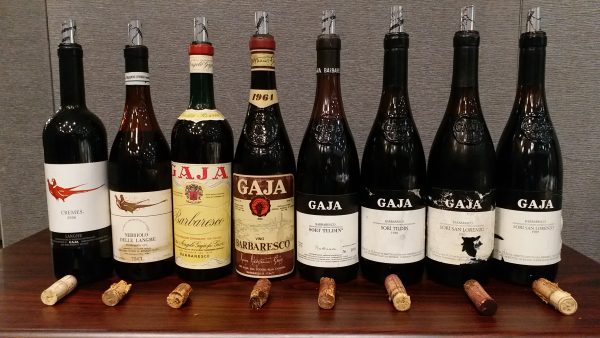
|
A. Gaja, Langhe Cremes, 2006 |
|
B. Gaja, Nebbiolo I Fagiani d' Oro, 1976 |
|
1. Gaja, Barbaresco Vecchia Riserva (1954 or 1955?) |
|
2. Gaja, Barbaresco, 1964 |
|
3. Gaja, Barbaresco Sori Tildin, 1979 |
|
4. Gaja, Barbaresco Sori Tildin, 1988 |
|
5. Gaja, Barbaresco Sori San Lorenzo, 1983 |
|
6. Gaja, Barbaresco Sori San Lorenzo, 1989 |
最新的兩款(1988 與 1989)在一天之前開瓶,其餘的 Barbaresco 在11 小時前開,作爲開場的兩瓶則 3 個小時前開,之後拔塞作瓶醒。
熱身的兩款各有特色。
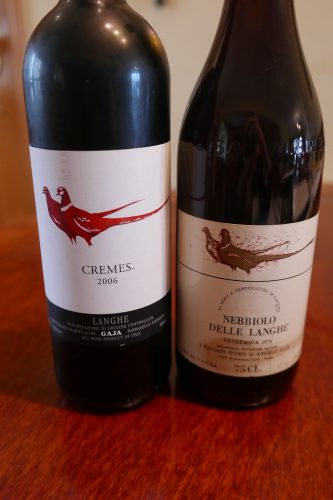 A. Gaja, Langhe Cremes, 2006 是 Dolcetto 與 Pinot Nero 的混釀,漆黑一片的,背後依稀有花兒數朵,既喝不到多汁的 Dolcetto,也辨認不出 Pinot Nero 的優雅,或許這正是 Angelo 的用意 — now you see me, now you don’t。
A. Gaja, Langhe Cremes, 2006 是 Dolcetto 與 Pinot Nero 的混釀,漆黑一片的,背後依稀有花兒數朵,既喝不到多汁的 Dolcetto,也辨認不出 Pinot Nero 的優雅,或許這正是 Angelo 的用意 — now you see me, now you don’t。
B. Gaja, Nebbiolo I Fagiani d' Oro, 1976 卻甚有可觀。1976 是多雨的糟糕年份,連達不到 Barbaresco 標準的 Nebbiolo 在放了超過 40 年後仍然散發著成熟的菌類香氣,通透,好喝。
第二回合有點散架,酸度搶高了一點,但依然好喝。
但我要説明的是這并非 Gaja 獨有的功力。幾年前我們也嘗了合作社 Produttori del Barbaresco 的 1976 Langhe Nebbiolo,記憶中比這瓶味道更豐富,也更持久,證明了 Nebbiolo 是 Noble grape,而 the Langhe 是 Noble land。
進入 Barbaresco,我們從老的喝到新的,頭兩款是 Angelo 的史前期,那是 Angelo Gaja 在 1970 年開始掌管酒窖以前的作品,酒標上用的是他爸爸 Giovanni 的名字。
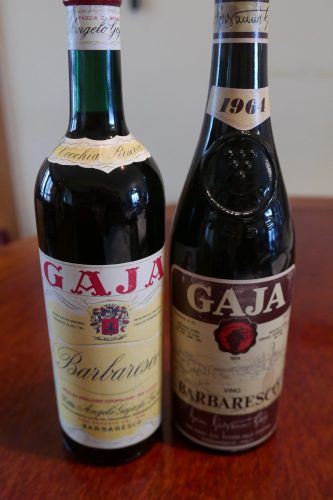 1. Gaja, Barbaresco Vecchia Riserva 的 Vecchia 是老舊的意思,我查資料知道 Gaja 在 1956 年才頭一次在灌瓶的酒標上年份,所以這瓶應該早於 1956 年。細心看酒標上的兩行字,説的是他們在 1951 年的 Asti 和 1953 年的北意比賽中拿了第一名,所以應該在 1953 年之後。1955 比 1954 年好很多,所以我懷疑應該是 1955 年。
1. Gaja, Barbaresco Vecchia Riserva 的 Vecchia 是老舊的意思,我查資料知道 Gaja 在 1956 年才頭一次在灌瓶的酒標上年份,所以這瓶應該早於 1956 年。細心看酒標上的兩行字,説的是他們在 1951 年的 Asti 和 1953 年的北意比賽中拿了第一名,所以應該在 1953 年之後。1955 比 1954 年好很多,所以我懷疑應該是 1955 年。
第一回合,1. Gaja, Barbaresco Vecchia Riserva 顔色淺而略混濁,先有老舊的氣味,伴隨的是濕泥土與蘑菇香氣,果與酸俱全,非常平衡,而且還感覺到丹寧的存在,一年前那瓶清純,這瓶可以說複雜,我講的是六十多歲,一點都不老的 Barbaresco!
2. Gaja, Barbaresco, 1964 的顔色淺而清澈,乾玫瑰的香氣,丹寧有若鋼絲,有一種懾人的張力,酸度好,像個瘦削但一身武功的師傅。
我們 11 人當中有 8 位更喜歡 2. Gaja, Barbaresco, 1964,但我認爲這款還沒完全打開,論當下的享受,我選 1. Gaja, Barbaresco Vecchia Riserva。
果然第二回合的 2. Gaja, Barbaresco, 1964 變得更複雜了,乾玫瑰之外還出了一些乾草本,烟絲,可能更近底部,顔色與果的濃度也更好,但仍然通透,難得的是那棉綫一樣的丹寧帶著我們前行。1964 的確是好年份,其全面性仿如近年的 2004,今天的表現幾乎無懈可擊,起初我看到瓶塞沾滿泥巴,還有點害怕,結果卻出乎意料的好。感恩!
但依我看,1. Gaja, Barbaresco Vecchia Riserva 在這回合更為精彩,似乎更年輕了,出了半鮮半乾的玫瑰,比剛才更甜也更酸,所以有種很活躍的感覺,複雜度也稍勝 1964。這仍是我的選擇。這回合有四位轉向,結果仍然由 2. Gaja, Barbaresco, 1964 勝出,差距縮窄為 7:4,但選那一款都沒錯,這兩款酒代表了傳統酒的最高成就,可與 Giacosa、Bartolo Mascarello 等齊比肩,這也是 Angelo 的起跑綫。
西諺有云:The rest is history。我在四年前的一場試酒報告裏曾引 Matt Kramer 來説明 Angelo 怎樣從酒評家領教了當時的風向,其中一段值得再引:
“It’s always been difficult,” he continues. “When I first started going to England in the early 1970s, this strong category, these connoisseurs, these Masters of Wine, they approached the Barbaresco, always sniffing, saying ‘salami skin’ or ‘chicken skin boiled in water with cabbage’ or ‘animal smells. It was really a surprise, because we were offering what we considered our best wines.”
(見﹕Matt Kramer on Wine, p. 268,試酒報告見:VIPa-3 第 5 場 — Gaja vs Produttori del Barbaresco)
當時正是 Angelo 在酒窖開展試驗之時,從潔净、發酵的溫度控制到瓶塞的大小諸事都有,最重要的可能是他對木桶的試驗。據説,從 1969 年起,他花了十年來試驗法國小木桶,1979 年他的新法正式登場。
他今天的定制是一年小桶,一年大桶,但剛開始的時候,小桶與大桶的比例一直在變﹕1981 年是 6 個月小 12 個月大,1982 年是 8-9 小 13-14 大,而 1985 年是 6 小 12-20 大,到 1988 年開始以後是一年小一年大,但小桶用的是甚麼桶,裏頭也有學問。Angelo Gaja 起初不滿意法國造的桶煙燻太厲害,所以他有一段時間自己用水和蒸汽先處理木條,然後才交給意大利的製桶工匠造桶(好像從 1990 年開始),但 Matt Kramer 在 2010 年出版的 Matt Kramer on Wine 裏提到 Gaja 又恢復從法國訂造木桶了。
所以 Angelo Gaja 用小桶的比例從 33% 開始增加到 50%,我們下面的兩組酒用意是比較這兩個階段的酒有什麽分別。
我們先試 Sori Tildin。田的原名是 Roncagliette,Gaja 擁有兩片,較高的位置他們起名為 Sori Tildin,Tildin 是 Angelo 的祖母 Clotilde Rey 的昵稱,Sori 是向南比較高的田;較低位置那片名 Costa Russi,是 Russi 屋子之意,因為 Gaja 是從 Russi 家買進這片田的。
Gaja 自己解釋這塊田的特點為:“Displays the roundest tasting profile of all Gaja single-vineyard wines. The rich body, supple texture and fine, ripe tannins are typical for this wine of great finesse, the quintessential expression of the land and the Nebbiolo grape.”
今天兩款酒的塞子很不一樣,1988 乾净,但 1979 滿布污泥,沾滿酒漬,而且這年開始使用特長的木塞,所以開斷了。
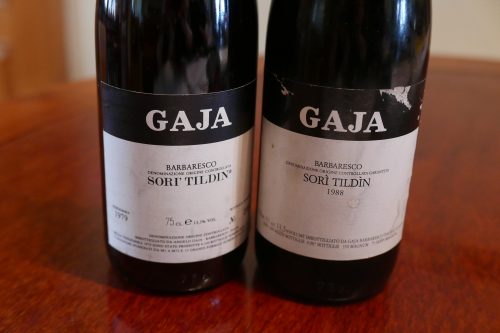 第一回合,3. Gaja, Barbaresco Sori Tildin, 1979 有一股濕而霉的氣味,隱秘的夾雜著些花香,入口有柔順的果味,一派傳統老酒的風範,喝起來像剛才的 Vecchia Riserva 與 1964 的風格。
第一回合,3. Gaja, Barbaresco Sori Tildin, 1979 有一股濕而霉的氣味,隱秘的夾雜著些花香,入口有柔順的果味,一派傳統老酒的風範,喝起來像剛才的 Vecchia Riserva 與 1964 的風格。
4. Gaja, Barbaresco Sori Tildin, 1988 有著截然不一樣的風格:桶味與果味搶在前面,通透,圓潤,但這時不太開放,貌似簡單。
我有點訝異發現這群初接觸意酒的朋友竟然更喜歡 3. Gaja, Barbaresco Sori Tildin, 1979,比數是 8:3。
第二回合,3. Gaja, Barbaresco Sori Tildin, 1979 的發展有點像 Vecchia Riserva,變得更新鮮,有更鮮味的玫瑰,甜美的果在口中完全融化了,酸度非常好。1979 是被人忽視的優雅年份,這瓶是很好的例子,而且 Sori Tildin 的圓潤也表露無遺。
此時的 4. Gaja, Barbaresco Sori Tildin, 1988 整合得更好了,但桶味也更明顯,技術上所有的要素都在,按主流酒評人的標準,這應該是高分數的酒,Matt Kramer 在差不多這個時候便參加過 Angelo Gaja 為 Michael Broadbent 安排的一場重要的試酒會。Broadbent 的名氣比很多 Master of Wine 都要大(他是發起創辦 Master of Wine 學會的其中一人),Matt Kramer 稱他為 The World’s Most Experienced Taster,但他的專長是法國酒,Nebbiolo 他試得不多,他上一次到 Piedmont 去大概是二十多年前!
這是很有趣的一幕﹕
At the midpoint of the dinner, just after the best Gaja wine of the evening was served — one of his “collector” Barbarescos from a single vineyard that never produces more than one thousand cases — Broadbent tasted the wine and then looked up, hoping to catch someone’s eye around the circular table. He caught mine. “This is terribly interesting wine, don’t you think?” Clearly it was a rhetorical question. He continued, “It really reminds me of nothing so much as Chateau Mouton Rothschild. Wouldn’t you agree?”
我懷疑 Broadbent 比若 Mouton-Rothschild 的那款酒應該是 Sori Tildin。磨劍二十年之後,Angelo Gaja 終於雪前恥了!Matt Kramer 接著這樣寫﹕
In fairness, Broadbent was set up. His response was precisely what Gaja set out to achieve after he returned from that deflating foray into Great Britain and Belgium twenty years earler.
可我這群朋友卻不與 Michael Broadbent 為伍,這回合有兩位轉投了 1988,但大部分人仍然喜歡較傳統口味的 1979,比數是 7:4。
我們最後一組是 Sori San Lorenzo。
這塊田的正式名稱是 Secondine,但 Gaja用了當地的守護聖人聖羅蘭來命名他們這款單一園。聽說 Angelo Gaja 本人最喜歡這塊田,Antonio Galloni 曾言 “The 1971 Barbaresco Sorì San Lorenzo remains one of the most historically significant wines ever made in Piedmont.” 此話沒有一點誇張。Gaja 自己解釋這塊田的特點為:“Almost always the most powerful and austere of Gaja’s 5 single-vineyard wines, it requires a longer time to fully develop. Highly concentrated fruit in addition to aromas of fine herbs, minerals and exotic spices. A very focused, concentrated wine with a long, lingering finish and refined tannins.”
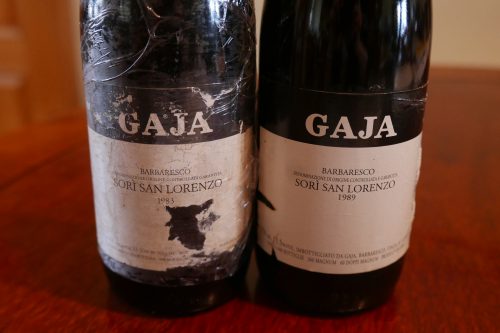 第一回合的 5. Gaja, Barbaresco Sori San Lorenzo, 1983 令大家嘩然,那香氣委實驚人:爆香的花與菌,雖然也有些桶香,但被强烈的花與菌壓下去了。1983 是個困難的年份,Angelo 便有此評價:
第一回合的 5. Gaja, Barbaresco Sori San Lorenzo, 1983 令大家嘩然,那香氣委實驚人:爆香的花與菌,雖然也有些桶香,但被强烈的花與菌壓下去了。1983 是個困難的年份,Angelo 便有此評價:
Another difficult vintage. It was important to choose the right date. There was a rain of four days. Some producers harvested too early. Those who waited after the rain had greater quantity. The quality became better but not great. It was possible for there to be a lot of difference in quality.
(見:http://terlatopiedmont.com/2012/10/04/angelo-gajas-notes-on-langhe-vintages-1958-2011/)
這款酒喝到今天終於到了 sweet spot,香氣驚人,口感也優雅,我看 San Lorenzo 這塊結構強如 Barolo 的田在弱年也不失骨架,最近一位朋友仍然津津樂道的向我提起多年前試的一瓶 1993 San Lorenzo,也是同樣道理。
把 6. Gaja, Barbaresco Sori San Lorenzo, 1989 放在這裏有點不公平,因爲這個歷來最好的年份之一,離成熟怕還有二、三十年,今天很 primary,丹寧强橫,我們喝到的是他的結構感,其他好像都缺席。
所以這回合由 1983 拿了全票。
第二回合,1983 仍然很香,不過出了些青椒,幸好口感有進一步發展,更扎實,更有深度,與 3. Gaja, Barbaresco Sori Tildin, 1979 相比是一雄一雌。
6. Gaja, Barbaresco Sori San Lorenzo, 1989 此時開放了一點點,但仍然只讓我們看到他的結構與漂亮的酸度,桶味明顯地比 1983 強,但豐富的口感足以蓋過桶味。
有一位朋友轉投了 1989,令 5. Gaja, Barbaresco Sori San Lorenzo, 1983 以 10:1 再勝一局。
Wine of the Night
我讓大家排出今天最喜歡的三款酒,按加權的方法算(第一名 3 分,第二名 2 分,第三名 1 分),結果如下:
第一名:5. Gaja, Barbaresco Sori San Lorenzo, 1983(20 分);
第二名:1. Gaja, Barbaresco Vecchia Riserva(19 分);
第三名:2. Gaja, Barbaresco, 1964(15 分)
後記
可否說 Gaja 今非昔比,而且小桶用得越少越好?
用科學的眼光,似乎我們還要再等 20-30 年,等到 1988 與 1989 完全成熟了,看他們有沒有 1955 與 1964 的魅力。
但以 Bordeaux 爲例,恐怕當果味稍爲消退以後,桶味只會更突出。
不過我恐怕沒機會見證這一刻。Angelo Gaja 也不會有。
但有一點是肯定的:即使 Angelo Gaja 沒有令 Barbaresco 變得更好喝,他起碼令 Barolo 與 Barbaresco 的市場地位大大提高了,從而鼓勵更多下一代從父業,這樣才會江山代有人才出。因此我們還得感謝 Angelo's Choice(請參看舊文:Angelo’s Choice)。
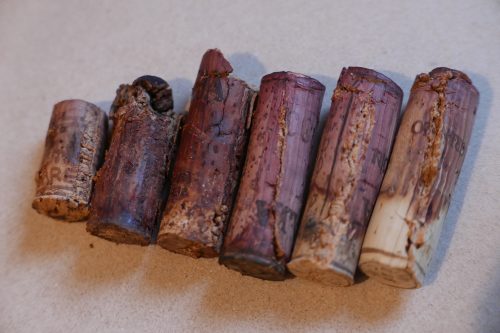
Gaja 從 1979 年開始用特長的塞子,以保證供應商會挑最好的材料給他,但開瓶器的雙手伸不了那麽長,所以開瓶是一大挑戰,老酒尤甚